Sanatruq I
Sanatruq I (Hatran Aramaic: 𐣮𐣭𐣨𐣣𐣥𐣲) was a king of Hatra, an ancient city in nowadays Iraq. He is known from more than 20 inscriptions found at Hatra and reigned from about AD 140 to 180. Only one of his inscriptions is dated (year 176/177). He was the son of Naṣru who reigned from about AD 128 to 140.[1] He was one of the first rulers of Hatra calling himself 𐣬𐣫𐣪 mlk (king), but he bears also the title 𐣬𐣣𐣩𐣠 mry' (administrator).[2] Both titles are also attested for his brother Vologash or Wolgash. It is unclear whether they both reigned together and took of the title king of Arabs .[1] His son and successor was Abdsamiya.
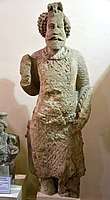 Statue of Sanatruq I, 2nd century CE. From Hatra. Erbil Civilization Museum, Iraqi Kurdistan.
Statue of Sanatruq I, 2nd century CE. From Hatra. Erbil Civilization Museum, Iraqi Kurdistan.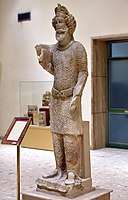 Statue of Sanatruq I, 2nd century CE. From Hatra. Iraq Museum.
Statue of Sanatruq I, 2nd century CE. From Hatra. Iraq Museum.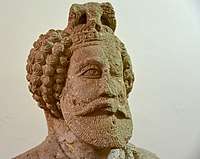 Sanatruq I, 2nd century AD. From Hatra. Erbil Civilization Museum, Iraqi Kurdistan
Sanatruq I, 2nd century AD. From Hatra. Erbil Civilization Museum, Iraqi Kurdistan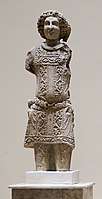 Prince Nyhr', son of Sanatruk I
Prince Nyhr', son of Sanatruk I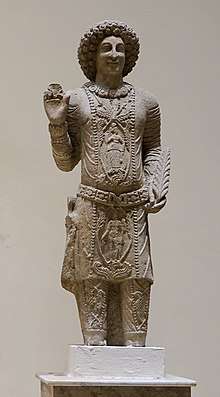 Prince Abdsamiya, son of Sanatruq I and future king
Prince Abdsamiya, son of Sanatruq I and future king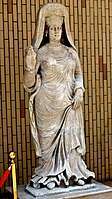 Statue of Abu Bint Deimon, wife of Sanatruq I. From Hatra, 2nd century CE. Iraq Museum.
Statue of Abu Bint Deimon, wife of Sanatruq I. From Hatra, 2nd century CE. Iraq Museum.
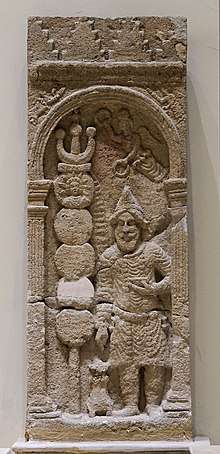
Relief of Sanatruk I, National Museum of Iraq
References
- Dijkstra (1995) p.178
- Dijkstra (1995) p.179
Literature
- Dijkstra, Klaas (1995). Life and loyalty: a study in the socio-religious culture of Syria and Mesopotamia in the Graeco-Roman period based on epigraphical evidence. Religions in the Graeco-Roman world. 128. Brill. ISBN 90-04-09996-4.
- Michael Sommer: Hatra. Geschichte und Kultur einer Karawanenstadt im römisch-parthischen Mesopotamien. von Zabern, Mainz 2003, ISBN 3-8053-3252-1, p. 23.
This article is issued from Wikipedia. The text is licensed under Creative Commons - Attribution - Sharealike. Additional terms may apply for the media files.